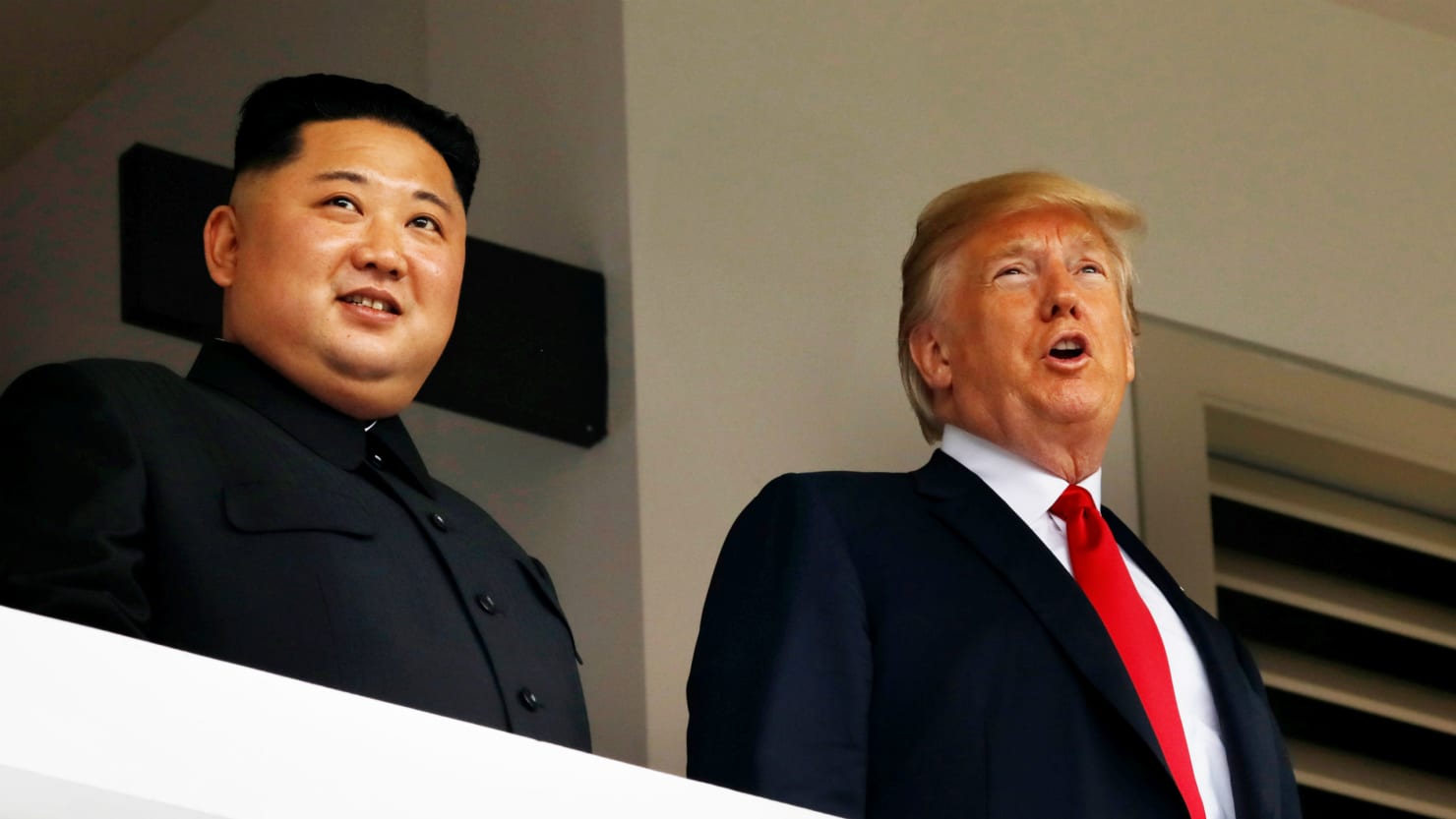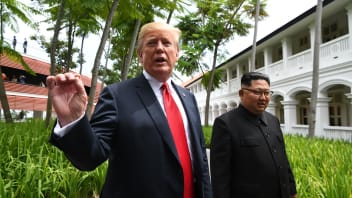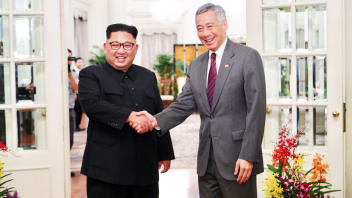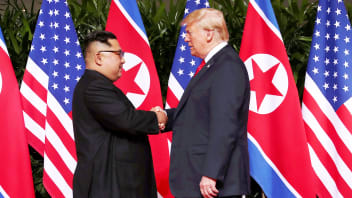
OPINION
REVIEWS ARE IN
Trump’s Singapore Summit Was a Bust—for the U.S.
The only language on ‘denuclearization’ the two sides agreed on in their joint statement was complete pablum, and it puts the future relationship with South Korea in doubt.
06.12.18 6:10 AM ET
The high-stakes diplomacy between the United States and North Korea has come to a wrap in Singapore. The summit—the first-ever between a sitting U.S. president and a North Korean leader—stayed mostly on-script.
But there’s little question that North Korean leader Kim Jong Un got the better end of the bargain out of the meeting; for Donald Trump, like previous U.S. presidents, the prospect of setting North Korea along the path to disarmament remains remote.
From the onset of the summit, which began with the much-anticipated first handshake between the two leaders at the Capella hotel in Singapore, it became clear that no matter what, North Korea would walk away with important propaganda coup.
From the arrangement of the flags to the seating arrangement at the bilateral sessions, there was little to distinguish this summit from one between two countries that share a decades-old hostile relationship and do not afford each other diplomatic recognition.
This was likely always going to be part of the package of offering to meet with a North Korean leader, which is precisely why previous U.S. presidents—all of whom could have offered to meet unconditionally with Kim Jong Un or his father or grandfather—chose to place a summit at the end of a diplomatic process with North Korea.
The idea was simple: Once North Korea had shown itself to comply in good faith with a process of implementing a robust agreement on denuclearization, it would receive the legitimizing capital associated with a summit with a U.S. president.
“'Better than nuclear war' shouldn't be the only yardstick we use to gauge the success of a summit like this.”
Instead, here we had Kim meeting Trump in exchange for little else than the release of three U.S. hostages in May. Though often framed as North Korean concessions to the United States, Kim made clear to highlight that his decision to close the nuclear test site at Punggye-ri and to enter a moratorium on testing intercontinental-range ballistic missiles was a sovereign choice—one that North Korea was making as a result of becoming a mature nuclear-weapons power.
RELATED IN WORLD NEWS
That, of course, brings us to the four-point Singapore declaration released by the two leaders. The document will be significant as the first to emerge out of a leaders’ summit between the United States and North Korea, but it does not stack up well against a long-running historical record of statements the two countries have put into writing.
The Singapore declaration was signed 25 years and one day after the June 11, 1993, U.S.-North Korea joint statement and underlined just how little the underlying structural factors that keep the United States and North Korea apart had changed in the intervening years.
What had changed in the meantime was North Korea’s capabilities as a nuclear power, which gave it all the more reason to run a tough bargain with Trump and negotiate as a country that had successfully developed multiple intercontinental-range ballistic missiles and thermonuclear weapons to place on them.
Unsurprisingly then, the only language on “denuclearization” that the two sides were able to agree to in a joint statement was complete pablum, building off the April 27 Panmunjom declaration between the two Koreas.
“Reaffirming the April 27, 2018, Panmunjom Declaration, the DPRK commits to work towards the complete denuclearization of the Korean Peninsula,” the Trump-Kim declaration notes. It eschews the U.S.-favored—albeit unrealistic—formulation of the complete, verifiable, and irreversible dismantlement of North Korea’s nuclear weapons.
But more seriously, this language only commits North Korea to the very same “complete denuclearization” that, in the Panmunjom declaration, approximates something like total global nuclear disarmament or bilateral arms reductions with the United States. And all North Korea will do, per the declaration, is work “towards” this objective.
But the language on denuclearization is the least concerning aspect of the Singapore declaration; it comports closely with pre-summit expectations that North Korea was not coming to Singapore to turn over the keys to its nuclear program.
The Singapore declaration predictably commits both countries to “establish new U.S.-DPRK relations” and to pursue a “lasting and stable peace regime on the Korean Peninsula.” Both of these points will support the April 27 Panmunjom process, initiated by South Korean President Moon Jae-in, but they throw the future of U.S. alliance with South Korea into flux.
More seriously, the agreement includes the following line: “President Trump committed to provide security guarantees to the DPRK, and Chairman Kim Jong Un reaffirmed his firm and unwavering commitment to complete denuclearization of the Korean Peninsula.”
We have few details on the nature of these guarantees—which are distinct from security assurances—but given that this accompanies North Korea’s vague commitment to denuclearization, it sets up the United States to follow through with serious adjustments to its military posture in the region. It’s not clear from the released text or any statements by Trump that North Korea’s conventional capabilities were considered in the course of talks on a security guarantee.
At the press conference at the conclusion of the summit, Trump announced that regular U.S.-South Korea joint military exercises—exercises that he chose to describe as “very provocative”—would be rolled back, granting Pyongyang a major concession.
The New York Times reported early Tuesday that the war games cancellation came as surprise to South Korea’s leadership—and the Pentagon. The AP reported Seoul’s presidential office told a reporter it was “trying to discern the exact meaning and intent of Trump’s comments.”
Viewed in the context of the momentum in U.S.-North Korea ties in late 2017—when talk of a U.S. military strike was growing worryingly common—the risks and costs of the Singapore summit seem entirely tolerable. The United States and North Korea have walked back from the brink and Trump, instead of threatening “fire and fury,” has suggested that he’d be willing even to invite Kim Jong Un to the White House.
But make no mistake: Viewed in the grand picture of decades of U.S.-North Korea relations, what just transpired in Singapore between the 45th president of the United States and the third North Korean leader was an asymmetric exchange.
Kim Jong Un goes back to Pyongyang with his long-desired photo op, having held on tight to his nuclear weapons and with no scrutiny whatsoever on human rights.
In the sense that the summit is an improvement over nuclear war, it was a success—Washington and Pyongyang will likely keep up a pageantry and bilateral momentum out of Singapore for some time. But “better than nuclear war” shouldn’t be the only yardstick we use to gauge the success of a summit like this.
Judged against 25 years of U.S.-North Korea joint statements, the Singapore declaration is a bust—for the United States, at least.





No comments:
Post a Comment